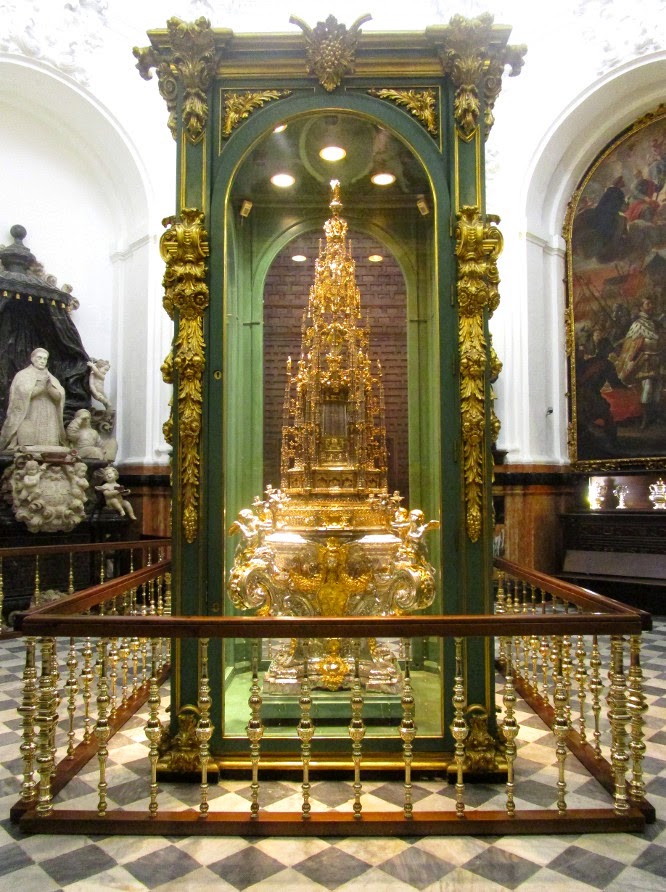If you're a heathen, like me, I'll save you some research time and explain that a monstrance is a vessel used in Roman Catholic, Old Catholic, and Anglican churches for the exhibition of some object of piety, such as the consecrated Eucharistic host..." (click here for more info from Wikipedia).
The Corpus Christi processional monstrance is a silver and gold creation made by Henry of Arfe, a German goldsmith. It weighs over 200 kilos (440 pounds). Since 1518, the monstrance has been carried through the streets of Córdoba during the Feast of Corpus Christi, 60 days after Easter Sunday.
What drew me to it was not it's massive size and obvious value — although the 'bling element' did draw my attention — but the tiny little human and animal figures throughout. It's my kind of art. I'd love to work on something like that. I wouldn't even have to use gold.
 |
| FRONT... TO GET A SENSE OF THE SIZE, NOTE THE 'DARK VISITOR" FAR RIGHT. |
 |
| ... AND BACK |
| I THINK THAT'S GREAT GRANDPA FERDINAND III IN THE BATTLE SCENES. |
| STATIONS OF THE CROSS. |
| I ALWAYS THOUGHT THE SONG WENT... "SIX GEESE A-LAYING." |
| THE LONE FIGURE ATOP THE 'BRIDGE'? AN EXTRA-TERRISTRIAL? |
| SAINT GEORGE BEING CHASED BY THE DRAGON WHILE THE BASEBALL TEAM LOOKS THE OTHER WAY? |
San Geraldo's god-daughter Erin (click here) does a brilliant imitation of Shirley Bassey. Sorry I didn't ask her to do a little video recording for me. You'll just have to make do with the original.

Mitchell it is very intetesting. And Photos are. Great worth visiting it.
ReplyDeleteGosia:
DeleteIt's fun to go back to a place like this again and again. There's always something new to discover.
Astonishing details.l
ReplyDeleteStephen:
DeleteAnd I've heard that's where the beauty lies.
Ohhhh! And I'm right in the middle of my medieval units in French 3 and French 4 --The Lion in Winter and all of that history in level 3, and Romanesque and Gothic cathedrals in French 4... I was just telling them both about relics, reliquaries, and the monstrance version (you know, the French word for to show is montrer).
ReplyDeleteLove this stuff :)
Judy:
DeleteSo sorry I'm not in France (to provide personal views for your classes, at least).
I remember an overwhelming monstrance at the cathedral on Toledo. Amazing artifacts!
ReplyDeleteDamien:
DeleteWe haven't yet been to Toledo, but I read about that monstrance while doing this blog post. Maybe a visit some time this year.
The photos and information are great, but I do have to ask: If it's an exceptionally huge monstrance would it then be known as a monstrancity?
ReplyDeleteI'd apologise for that but, hey, *I* was never the one who went through the 'normal' phase, lol. Thankfully the kidling got over it rather quickly.
As always, the music really made it for me!
Jacqueline:
DeleteSo glad you've never had a normal phase! I love the word monstrancity. But I don't think I'll share it with San Geraldo; it would quickly become a part of his vocabulary.
The detail of that Monstrance is simply incredible! Having been brought up RC and having been an altar boy, I am very familiar with the sacredness that is given this object in certain religious circles. Back when I was a kid, only the priests were permitted to touch this.
ReplyDeleteThanks for the detailed photos, Mitchell, simply amazing!
Jim:
DeleteSorry the photos aren't better quality. Taken through glass and a little rushed. But I'm glad you like them.
If these artefacts were produced with the object of arresting the congregation's attention with awe, as they surely were, there's no doubt they succeeded. Of course one can only wonder at their present-day worth, but now that they are in existence it would be an act of mad vandalism to have them destroyed, for whatever reason.
ReplyDeleteRay:
DeleteAfter my gasp of awe, my next reaction to these artefacts is to wonder how many of the world's problems might be solved with the wealth exhibited. Then, like you, I realize it would be shameful to send this incredible art off to the highest bidders around the world after all these years. And then I get really depressed and realize good-thinking people would probably have no say in where the money went anyway. Still, it 'sho is perty.'
I see a couple of bits that look like you could snap off quite easily. They would look nice in your apartment.
ReplyDeleteAndrew:
DeleteIt wasn't as easy as it looked. (Shhhhh)
I heard tell these side chapels were once upon a time used for masses for the dead even though no one was present, priests were paid to do them to get people out of purgatory - or they did them until Mr. Luther came along and spoiled the system.
ReplyDeleteSpo:
DeleteI had no idea money could even be used to buy your way out of purgatory.
That my friend was the heart of Mr. Luther's 95 complaints in 1517.
DeleteWonderful photos. Thanks
ReplyDelete